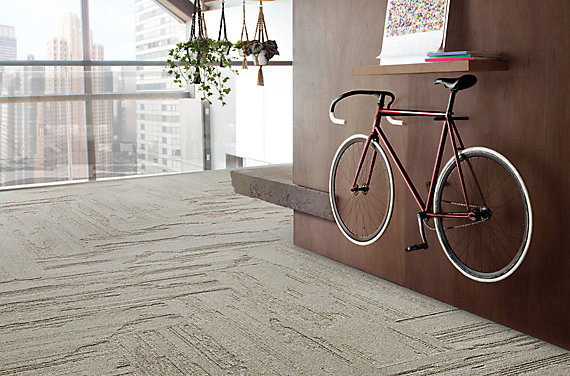Since the advent of the Industrial Revolution, manufacturing had been synonymous with pollution and poor working conditions. From sweat shops at the turn of last century in the US (which continues to this day in other countries around the world), to images of factories belching out black smoke, the creation of products may fuel our economy, but it also contributes to a poorer environment. Is it possible to makes things – at a large-scale – and not damage the environment or people’s health? One carpet company has been the leader in a shift from traditional manufacturing processes to more sustainable ones not only in its industry, but also for all manufacturers of goods.
Interface Carpet is a global company founded in America by the late Ray Anderson in Dalton, Georgia. It began as a typical carpet company – heavily reliant on fossil fuels and petrochemicals. The typical carpet manufacturing process – from fibers to dye all the way through to the delivery of product needs fossil fuels to function. According to his book, Confessions of a Radical Industrialist (2009), in 1994 Mr. Anderson had an epiphany about his livelihood after reading The Ecology of Commerce by Paul Hawken. He realized that by producing carpet he was irreversibly damaging the environment. But instead of giving up or ignoring it, he tasked his employees to help him recreate the carpet company with sustainability in mind. His goal was this:
“Be the first company that, by its deeds, shows the entire world what sustainability is in all its dimensions: people, process, product, place and profits and in doing so, become restorative through the power of influence.”
Since then, Interface has tackled every aspect of their company to meet such a lofty goal. The list is extensive and grows every year. Here are some highlights:
- Mission Zero– their ongoing quest to reduce their overall environmental footprint to “zero,” by 2020, just 3 years away,
- Net-Works, a collaborative effort that uses discarded fishing nets in their carpet products. “To date, Net-Works has removed over 80,000 kg of nets from the ocean and coastal areas in the Philippines.”
- Cool Carpet, a program that helps with carbon offsets where their current manufacturing and shipping practices cannot reduce carbon emissions.
- Interface has reduced its waste which has “resulted in a 91% decrease in total waste to landfills from our carpet factories since 1996.”
- They have harnessed the energy from methane gas at a local landfill to power one of their plant’s operations.
All of these initiatives and more have helped Interface reduce their overall greenhouse gas emissions to almost zero as indicated in the graph from their global website.

And this is just in their US manufacturing facilities. Their European facilities have reported an overall carbon reduction of 98% per square meter, a 95% water reduction since 1996, operate their manufacturing facilities on 95% renewable energy and send nothing to landfills – all while increasing their business.
Interface has also used biomimicry in the design of their products to reduce waste. For example, the modular system of carpet tile allows the end-user to replace tiles as needed. However, the new tile, when placed within the old tiles always looks out of place. Through the use of biomimicry, Interface designed patterns that allow for the random placement of tiles without regard for a specific pattern. This system has an economic advantage, too – using less carpet not only means less waste, it also lowers costs.

Interface has become the world’s leading carpet manufacturer, not through doing business as usual, but through innovation with the planet, people and profits in mind. In the years to come, Interface has moved beyond just not doing harm, they are moving into a new phase of sustainable design that looks to renew and restore our fragile environment.
